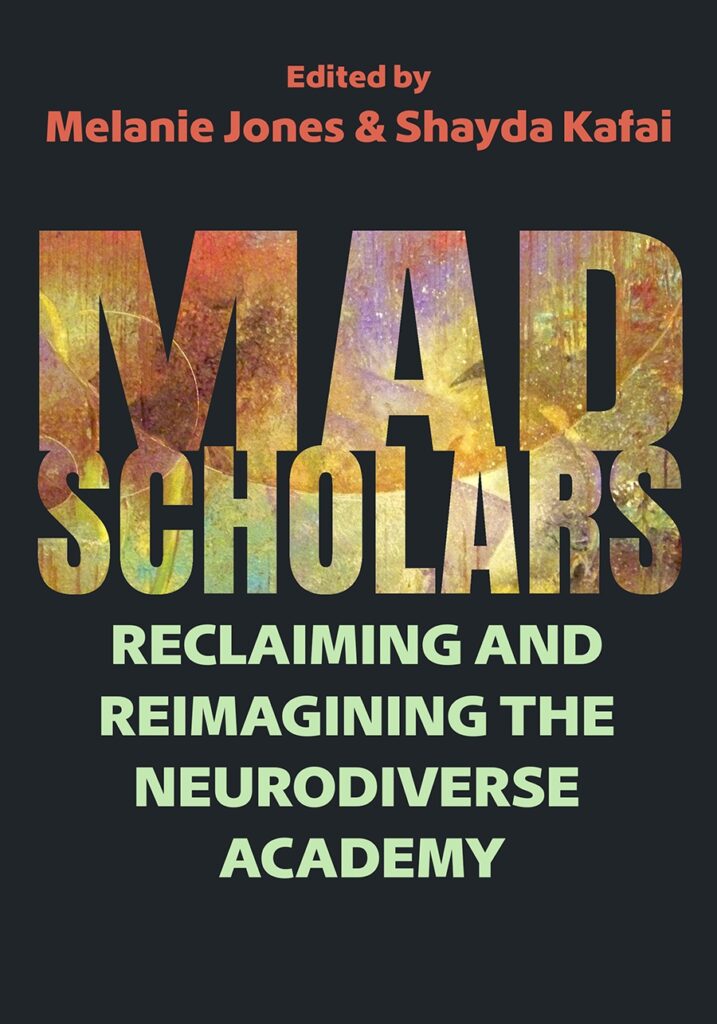The following is an excerpt from Mad Scholars: Reclaiming and Reimagining the Neurodiverse Academy, edited by Melanie Jones and Shayda Kafai and published by Syracuse University Press, Copyright 2024 by Syracuse University Press. The excerpt is drawn from the introduction, written by the editors.
This collection explores how our Mad selfhood is understood, articulated, and engaged through our capacity as scholars. It wonders where we might go if we embraced that overlap instead of shunning it: if we probed its depths and exploded its boundaries.” From the start, Mad Scholars has emerged from a place of hopeful, desperate imagining. What does—and what could—it look like to be Mad in academia? What does—and what could—it mean to claim such an identity openly as a researcher, an educator, and a member of a broader intellectual community?

These are not idle questions. In Mad at School in 2011, Margaret Price called on faculty and administrators to interrogate “the stories that are told about mental disability in U.S. higher education” and to consider “what it means to have a disabled (unsound, ill, irrational, crazy) mind in the educational realm, a realm expressly dedicated to the life of the mind.” Since this book’s publication, crucial texts have detailed the manifold ways in which ableism and sanism pervade North American colleges and universities. A growing number of monographs and essay collections have been dedicated to exploring the theoretical implications of disabled scholarship and to unpacking specific barriers to equity, accessibility, and care.
Mad Scholars takes a different approach: imagining concrete paths to Mad education and liberation, framed in languages that have been too long denied. Twenty-five voices from the United States and Canada, spanning almost a dozen disciplines and covering every stage of academic scholarship, join here to assert our divergent bodyminds in defiance. We reject the suffocating rigidity of academic sanism, whose forces pathologize us and treat us as problems to be excised or contained. We refuse the implicit mandate that educators must feign nonconformity and pay lip service to diversity while ignoring those voices desperate for concrete change. We assert the unspoken secret of academic life: that Mad Scholars have been here all along. We—the neurodivergent, the neuroqueer, the disabled, the disordered, the crip—are part of the backbone of academic life and remain a major force in its innovation.
What can we discover when we don’t just acknowledge sanism but also interrogate the ways we push back against it? What can we imagine if Mad scholars were no longer exoticized or pathologized but were treasured as resources, recognized as assets, and embraced as potential change makers? Such questions cannot be answered by a single voice, nor should they be read through the lens of one monolithic perspective. As the following section elaborates, our contributors interpret the label Mad scholar through many lenses and incorporate myriad definitions and identities under the umbrella term Mad. What this collection is not, then, is any attempt to essentialize what a Mad scholar is or to present Mad identity as a homogenous collective. We call for recognition and for honest engagement, but this call is not raised under a banner of transcendent revelation. The multifaceted, varied experiences of Mad scholarship can encompass disorientation, pain, and struggle as much as it can empathy, creativity, or challenges to the status quo. We are not ignorant of the incredible privilege we hold in claiming the identity of a Mad scholar. Nor are we unaware that this (re)claiming, if embraced too unquestioningly, may further alienate and silence those whose experiences cannot be rehabilitated into a generative subject position.
We gather instead to further move our culture’s broader understanding of disability from “textual abstractions” to “tangible bod[ies].” We similarly aim to shift conversations in and about academia specifically to center the “potency of disability as an experience of social or political dimensions” (Mitchell 2002, 16). These twenty-two chapters position Mad scholars as a community whose knowledge and skills are not only acceptable but also crucial to reorienting and reimagining higher education. The still controversial assertion that someone can “both be mentally ill and lead a rich and satisfying life” (Saks 2007, 333) is not the close of our arguments but their beginning. What binds our contributors, amid their diverse backgrounds and perspectives, is their commitment to recenter Mad scholarship as an abundant yet undervalued resource. We are not here to say we can do the work of scholarship, too. We are here to affirm that we have been doing it in different and potentially far better ways than the current system would ever permit or know and that we seek intersectional, interdisciplinary alliances to revolutionize that system further.
Mad Scholars invites those outside our community to witness and learn from this meaning making. More than this, however, it provides a place for us, one of vulnerability, connectivity, and kinship. This collection, ultimately, is for you: the crip undergraduate struggling to finish her thesis; the neurodiverse researcher failing to get funding for his fieldwork; the Mad educator fighting for the classroom they envision; all Mad scholars who have spent decades patching together spaces of communion and hope. The lived knowledge you carry is our lifeblood. The synthesizing and complicating and invigorating of these knowledges are the first steps we take to reimagining a space worthy of the identity we claim.
Mad Scholars is available now.

